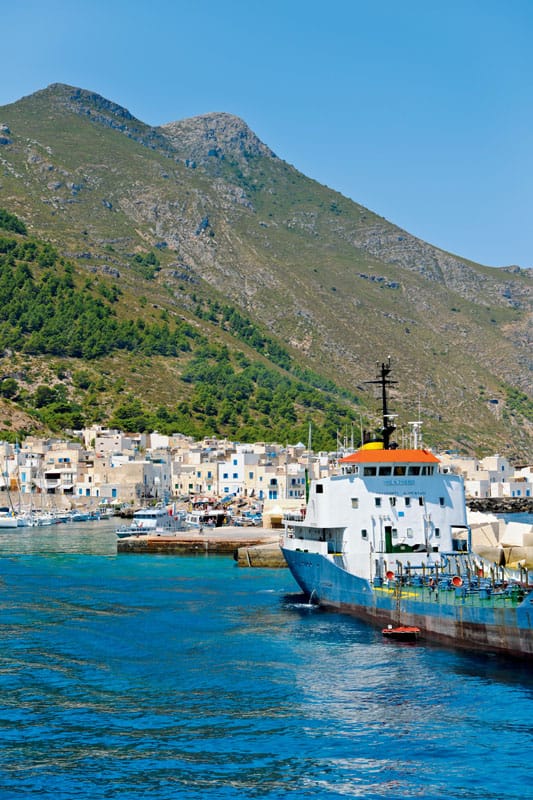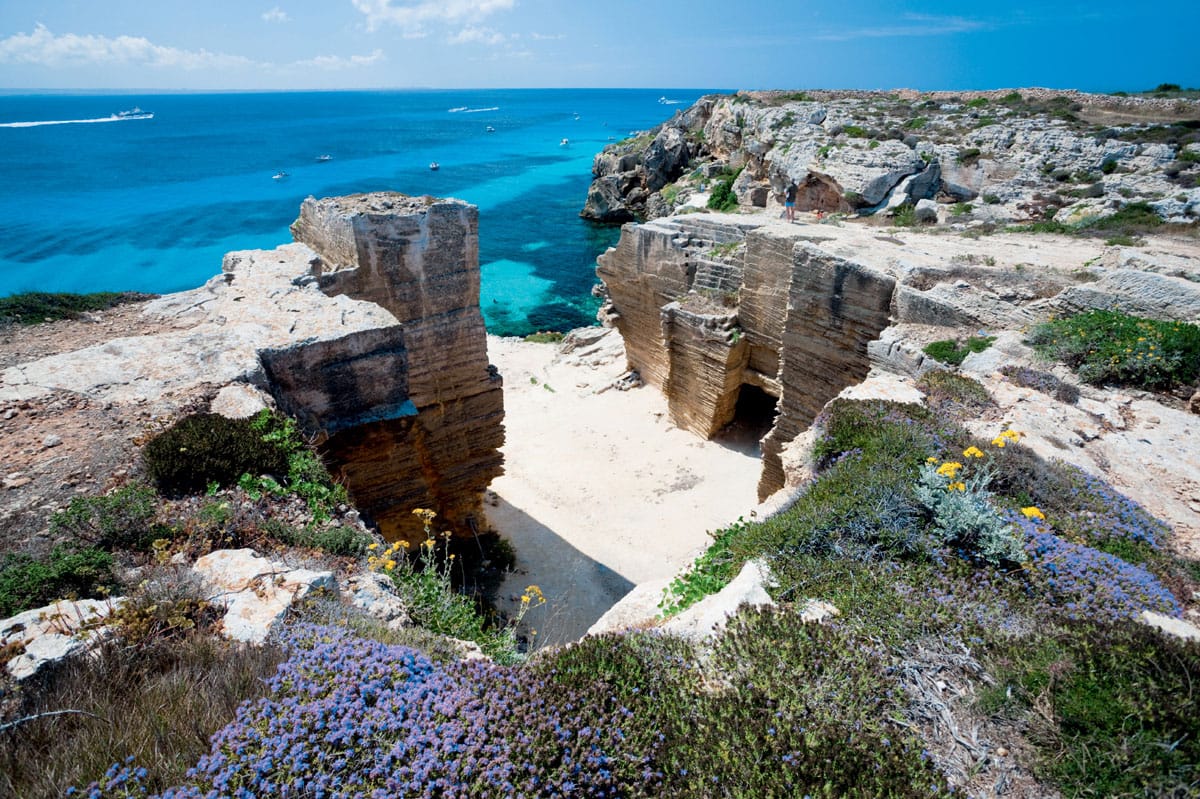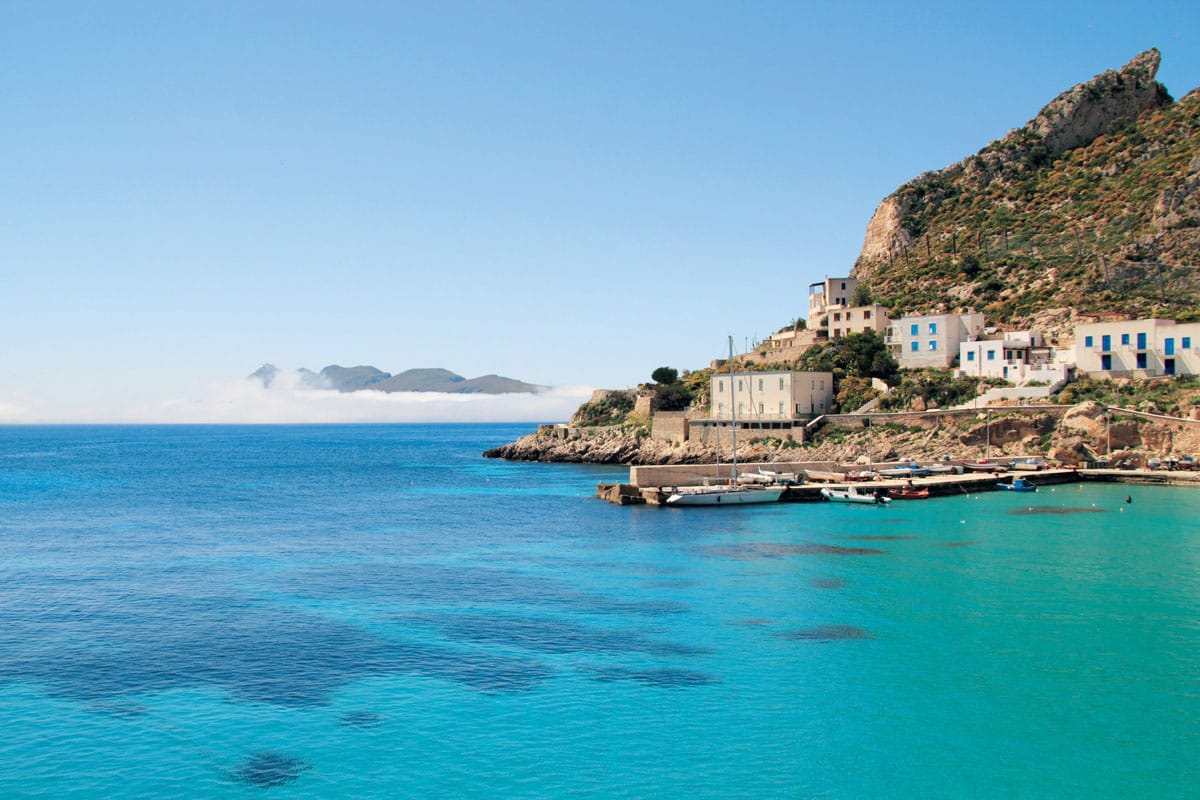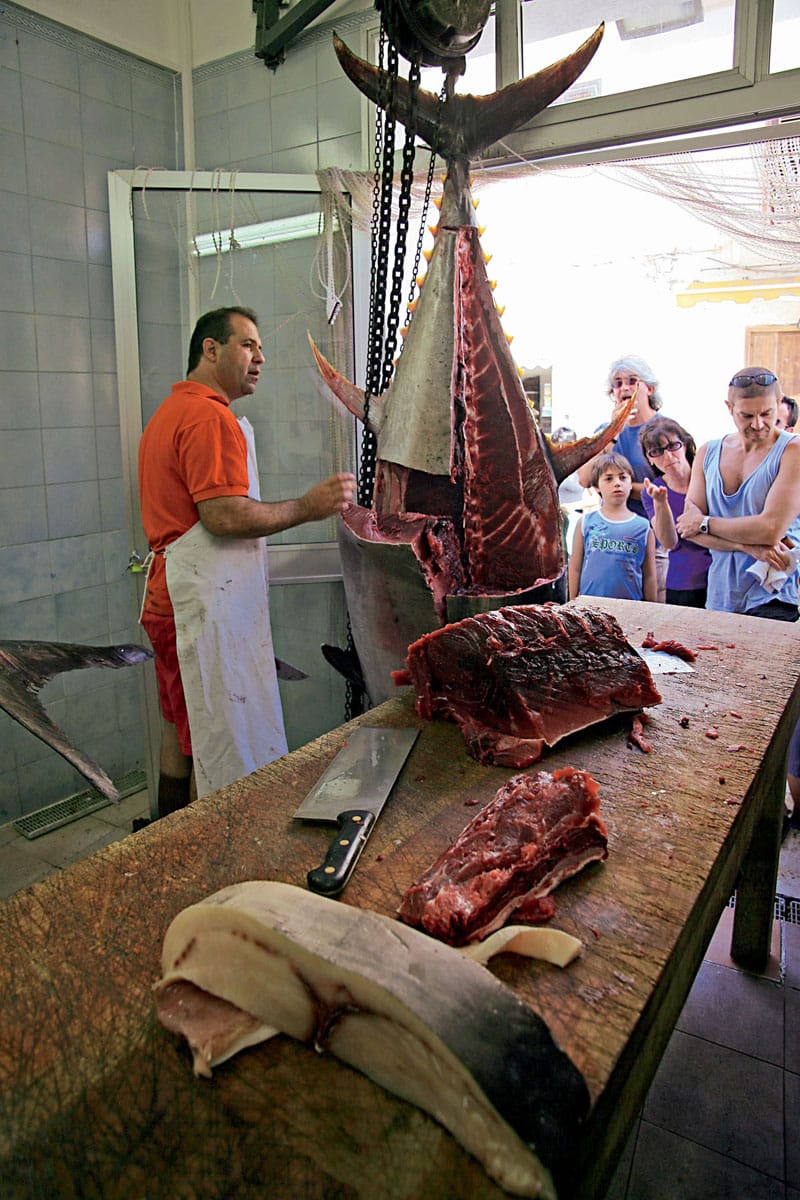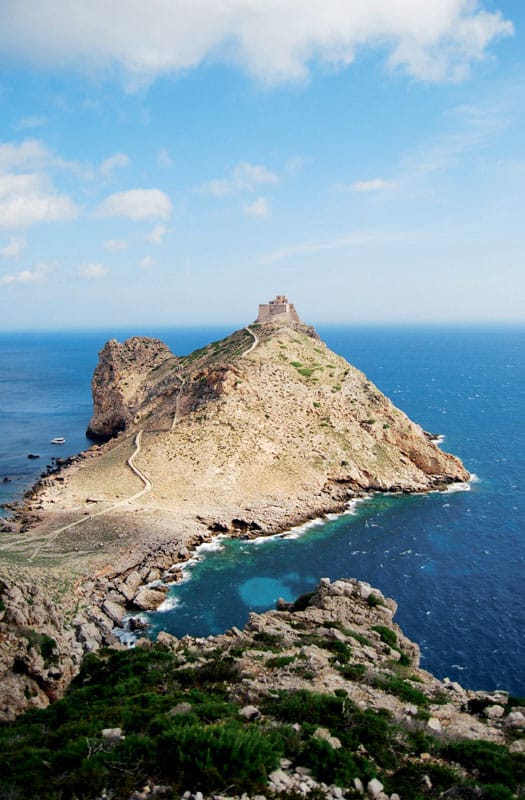The Egadi Islands and Pantelleria
As the easiest offshore islands to visit, the Egadi attract summer crowds, but out of season they offer peace and traditional charm. Much further south lies Pantelleria, Sicily's island close to the shores of North Africa
The port at Maréttimo island, a paradise for divers.
Neil Buchan-Grant/APA
As a short ferry ride from Tràpani, the archipelago of the Egadi Islands (Ísole Égadi) are deservedly popular. Set in a marine reserve, Favignana, Lévanzo, and Maréttimo are a paradise for sailors, scuba-divers and fans of tuna fish. Today, fishing and tourism keep the economy alive, and the recent restoration of the tuna fishery has given the island of Favignana a new focus.
Cave drawings
The Egadi have 15,000 years of history, and the caves of Favignana and Lévanzo contain traces of the islands’ prehistoric settlers. In Lévanzo, cave drawings in the Grotta del Genovese etched 12,000 years ago show bulls and deer as well as hunting men. It is thought the archipelago was once part of a land bridge linking Africa to Italy.
The islands were the springboard for the Arab conquest of Sicily and the great traders, the Phoenicians, then settled here and remained until despatched by the Romans. Over the centuries the Saracens and the Normans followed, then the Aragonese and, finally, the Genoese. The Normans and Aragonese fortified the Egadi, while the Spaniards encouraged the growth of a coral industry.
After Spain sold the islands to Genoese bankers in 1637, the economy took off and reached its peak under the entrepreneurial Florio family in the early 19th century, when both tuna and tufa (volcanic rock) were exported.
Favignana, the largest of the Egadi Islands.
Neil Buchan-Grant/APA
Favignana
At 20 sq km (8 sq miles), Favignana, home to around 4,400 people, is the largest and most populous island. Ancient tufa-quarrying remodelled the landscape until it was brought to a standstill in the 1950s by the high cost of extracting and transporting the rock.
Book an archaeology-themed walking or cycling tour of Favignana with Ancilla Finazzi (tel: 3898 048 028) or check other walks with the tourist office (Largo Marina 14, tel: 0923 545 511).
The island is a homage to stone, its slopes dotted with tufa houses. Even cliffs and caves represent a pleasing spectrum of ochre, russet and cream-coloured rocks. However, if cyclists heading for one of the coves stop to peer over the roadside stone walls, they will discover an abundance of sunken gardens. These sheer stone walls, overgrown with wild fennel and capers, give shelter from the sweeping sea winds to the orange and lemon trees, as well as the figs and tomatoes planted below on the floor of the abandoned quarries. Other quarries were carved at the very edge of the sea too, so that the tufa could be loaded directly onto the boats transporting it to the mainland. Stone from the maze-like Cala Rossa * [map] helped build many cities in Sicily and North Africa. The chiselled walls and eroded geometry of the seaside quarries make Cala Rossa a popular spot for picnics and swimming.
Cala Dogana, the port at Lévanzo.
Neil Buchan-Grant/APA
In the bustling medieval town of Favignana ( [map], to one side of the ferry quay in the port, near where the ferry docks, stand beautiful vaulted warehouses in which the big black-bottomed tuna boats, the long nets and huge anchors are stored during the winter. The still waters of the harbour reflect the tiled roofs and stone smokestacks of the Tonnara di Favignana, a former tuna cannery, which closed in the 1990s (all processing is now carried out in Trápani). Previously known as Tonnara Florio, this masterpiece of industrial archaeology has recently been converted into a heritage museum covering the tuna business (Tue–Sun 10am–1pm, closed in winter; tel: 0923 808242).
Palazzo Florio, built in 1876, was once the home of the tuna tycoon Ignazio Florio. Today it contains the tourist office (tel: 3385 366 075), town hall and a cultural centre. The palazzo and the statue of Ignazio Florio in Piazza Europa recall the island's heyday. In Florio's time, a day's catch could be as high as 10,000 fish. Today, it has shrunk to under 2,000 a month because of overfishing. Even so, the tuna industry survives, with traditional techniques allied to hi-tech sonar detection, used to spot the shoals.
If tuna is on your mind, call into Sapori di Mare (Via Roma 23) to dine on tuna prepared 50 different ways, from tuna caponata to sweet and sour tuna.
Also in town is Forte San Giacomo, a fortress built by Roger II in 1120, later converted into a Bourbon prison in 1837, and today housing a maximum-security prison for some of Sicily's finer mafiosi.
Palaeolithic caves
Eastwards along the shore is Punta San’ Nicola, awaiting excavation of its caves that were inhabited in Palaeolithic times, Bagno delle Donne (once the women's baths), and Cala Rossa where the sea was said to have turned red in 241 BC during a bloody battle between the Carthaginians and Romans. Also in the east, in the Bue Marina area, see the Giardino dell'Impossibile , [map] (daily 4–7.30pm; tel: 0923 921 501) botanical and tropical gardens “impossibly” thriving in an ancient tufa-stone quarry.
Lévanzo
The smallest island, and the one closest to the mainland, bears witness to the islanders’ bond with the sea. Much of the coast is still inaccessible, except by boat. The port of Lévanzo ⁄ [map] (or Cala Dogana, because the Customs offices are here) consists of a handful of houses with rooms to let, a couple of small hotels, several cafés and trattorie.
Its one tarred road turns into a dirt track as it leaves town and winds along a gentle valley between the peaks of the Pizzo del Mónaco and the Pizzo del Corvo. The stony slopes are covered with macchia mediterranea, arid-looking grey-green scrub that turns lush with the winter rains and blooms in spring.
View of the Egadi Islands from the mainland.
Neil Buchan-Grant/APA
Marine caverns, reefs, rainbow-coloured sponges, ancient wrecks and archaeological sites are all part of the Sicilian diving experience. Although Ustica is, by common consent, an experienced diver's first choice, all the offshore marine reserves offer good diving. The Egadi Islands’ crystalline waters teem with marine life and are popular with snorkellers as well as divers. On the island of Favignana, snorkelling and scuba-diving enthusiasts appreciate the waters off Punta Marsala, Punta Fanfalo and Punta Ferro, including the underwater cavern between Scoglio Corrente and Cala Rotonda.
Serious divers or underwater photographers might wish to make the island of Ustica their base. As Sicily's best-established marine reserve, Ustica's waters reveal an explosion of colour, from corals, sea sponges and anenomes to barracudas, breams, scorpion fish and groupers. Deep-sea archaeological excursions also explore wrecks and inspect amphorae in their original sites on the seabed. Ustica can be visited on a day trip from Palermo.
But even the top resorts should be able to set up a customised diving or snorkelling experience. From Taormina, the most popular dives are around Isola Bella and reveal octopus, schools of fish and a selection of corals. The beautiful Blue Grotto dive (at a depth of 16 metres/52ft) showcases colourful corals and eels lurking in craggy walls. Far more challenging is the dive to the so-called “Roman temple” (at a depth of 26 metres/85ft), the result of a shipwreck over 2,000 years ago. These ghostly white marble columns were intended for a temple at Taormina until the Roman ship came to a sticky end off Capo Taormina.
At the head of the valley the track forks: the left-hand path zigzags down the steep coast towards the sea, leading to the Grotta del Genovese ¤ [map], a deep cavern overhanging the rocky shoreline. It is Lévanzo's greatest treasure. If the sea is calm and the wind right, you can reach the grotto by boat, combining a visit to see the ancient carvings with sailing and swimming from a craft hired at Cala Dogana (or book with the custodian of the grotta: Signor Natale Castiglione at Via Calvario 11, near hydrofoil quay; tel: 0923 924 032).
The cruel ritual is both a gory tradition and a gruesome spectacle that survives despite conservationists’ concerns and the contravention of rules on driftnet fishing
Tuna fishing is rooted in the Sicilian psyche. Nowhere is this more so than in Favignana, where it is considered the sea's ultimate challenge to man, as well as the island's traditional livelihood. The tuna's only predators are the killer whale, the Mako shark and man, and their ritual death here at the hands of fishermen is both gruelling work and a disturbing spectacle.
The season lasts from May to mid-June, with the ritual mattanza, the traditional method of tuna slaughter, as the inexorable fate of the passing shoals. The fast-swimming tuna hunt off the coast of Norway but spawn in the Mediterranean's warm waters. Shoals circle Favignana where they are captured in a system of huge chambered nets (tonnare) introduced by the Arabs in the 9th century. Buoys mark out a 100-metre (330ft) rectangle; up to 10km (6 miles) of nets are suspended between the floats. Halfway along lie five antechambers. The innermost section is the camera della morte, the death chamber 30 metres (100ft) deep. At dawn, or when the winds are right, the helmsman leads the fleet in prayers, aided by an image of the Madonna. The 60-strong crew sings and chants the cialoma in guttural tones. Entreaties are uttered by the rais, a Moorish title given to the chief fisherman, who travels in a separate boat and constantly checks the entrance to the camera della morte.
The black boats encircle the nets. When the rais decides that the currents are right, the shoal is steered into the death chamber and the gate closed. As it fills with fish, the floating death trap sags, like a heavy sack. To the command of “Tira, tira!” (pull, pull!) the net is pulled tight. The rais chants the fateful battle cry. Each verse of this bloodthirsty sea shanty has a chorus of “Aiamola, aiamola”, perhaps derived from Allah! Che muoia! (Allah, may it die!).
As the net is drawn in to the length of a football pitch, the fish circle frantically in the sarabanda della morte, the dance of death. The chanting stops and the slaughter begins. The frantic fish are harpooned and caught behind the gills with long pole-gaff hooks to be dragged onto the boats. Some of the tuna are man-sized.
As the silvery fish are pierced, the frothing water is stained red. It takes a frenzied 15 minutes and a sea of vivid red to slaughter about 200 tuna, although some die of heart attacks or over-oxygenation. With true Sicilian logic, the tuna's breeding grounds also become their tragic end.
Dividing up the tuna.
Neil Buchan-Grant/APA
Drawing of the annual mattanza on the wall of a shop in Favignana.
Neil Buchan-Grant/APA
The rock carvings are prehistoric and were not found until 1949. Etched into the soft stone about 10,000 years ago, they include impressions of human dancers and wild animals in naturalistic poses. More recent ones of men, women and fish were created about 5,000 years ago.
Most of the rest of the island is inaccessible, and there are only a few inlets for swimming.
Maréttimo
The most mysterious, mountainous and greenest of the Egadi Islands, Maréttimo lies to the west, separated from its sister islands by a stretch of sea rich in sunken treasure. Here lie the remains of the Carthaginian fleet destroyed by the Romans in 241 BC.
The little port of Maréttimo ‹ [map] has no hotel, but manages with a few serviced apartments and enthusiastic B&B arrangements. Peace and natural beauty are what draw visitors here. Scuba-divers come to explore the 400 caves and grottoes scattered along the coast; plant-lovers study the Mediterranean vegetation at its purest. The rest simply want to relax, swim in the aquamarine waters, or take three-hour trips in the brightly coloured traditional boats around the coast.
Ambitious visitors will climb up to survey the island from Monte Falcone (686 metres/2,250ft). An easier walk is an excursion to Case Romane, not houses but ruined Roman fortifications not far from the village. (From the port follow directions to Pizzeria Filli Pipitone.) Beside the ruins is a crumbling Arab-Norman chapel.
An alternative hike leads north along the cliffs and cuts across an isthmus to Punta Tróia › [map], a rocky promontory dominated by a Saracen castle. Originally a watchtower, the castle was enlarged by Roger II and converted by the Spanish into its present form, with an underground cistern that later did service as a dreaded prison. But such sombre thoughts quickly float away on this restful, thyme-scented island.
In summer, hikers should always carry bottled water with them. On these parched islands, water is more precious than wine.
Pantelleria is famous for its sweet raisins and for its wines, especially Moscato di Pantelleria produced from its sweet moscato grape, Zibibbo. The wine made from raisins is Passito, usually highly scented with almonds.
Punta Tróia, Maréttimo.
Neil Buchan-Grant/APA
Pantelleria
Pantelleria is closer to Tunisia's Cap Bon, 70km (44 miles) away, than to Sicily, which is 110km (68 miles) distant, and is reached on a six-hour ferry crossing from Trápani, or by air. At 83 sq km (247 acres), it is the largest island off Sicily, with a population estimated at 7,600. The island's evocative name probably derives from the Arabic “daughter of the winds”, after the winds that can buffet this rocky outpost, even in August. The island is dotted with dammusi – cube-like, low-domed houses – and surrounded by terraces used for growing capers or grapes; even the vines are trained low to protect them from the winds. The landscape is dramatic and relatively bleak but enlivened with hot springs, jagged rocks and coves instead of beaches. Many mainland Italians, especially from Milan (like fashion designer Giorgio Armani) have summer retreats here.
You can bring a car on the traghetto (ferry) from Trápani. However, on Pantelleria it's easier to rent a moped or use the bus service between the town and Scauri and Tracino. Bicycles and motorscooters can also be rented in town. The tourist office is on Via San Nicola (tel: 0923 911 838).
Pantelleria town
Pantelleria town fi [map] was bombed heavily during the Allied forces invasion of Sicily in World War II, so charm is in short supply. But the island itself has a lively air as well as an exoticism encapsulated by the white-cubed houses and restaurants that serve fish couscous.
Pantelleria was originally founded as a trading post by the Phoenicians. Its small harbours provided excellent protection for the small ships of the day. The island was captured by Rome but eventually – after the Vandals and Byzantines – it was the Arabs who claimed it and introduced farming.
A rewarding hike or a bus ride from Pantelleria town to the port of Scáuri fl [map] on the southern coast passes the traditional domed, white-washed dammusi houses, framed by terraced vineyards, small settlements and expanses of blackened, lava-stone landscape. The dry-stone walls enclose citrus groves and often appear to have hardy, locally bred donkeys peering over them.
Dammusi house on Pantelleria.
Neil Buchan-Grant/APA
The route also passes strange Neolithic dome-shaped funerary monuments, known as Sesi, conceivably built by early settlers who arrived here around the 18th century BC. Little is known of the Sesi people; it is assumed they came from Tunisia on foot before the Mediterranean Sea developed. They built circular domed structures using the island's volcanic rock, similar in shape to the dammusi. At Mursia their village with Sesi structures was protected by walls. Its name, Alta Mura, means High Wall.
Hot springs and mud baths
The island's volcanic origins are visible in the presence of lava stone, basalt rock, hot springs, stufe (volcanic steam vents) and a landscape pitted with small cuddie (baby spouts), which are extinct volcanic craters. On Monte Grande (836 metres/2,743ft), near the hamlet of Bugebera, lies a lake in an old crater full of warm, bubbling, sulphurously brown waters, known as Specchio di Venere (Venus's mirror) and used by local bathers to cure myriad ills. The water here can reach 50°C (122°F) because of a hot spring. Bagno d'Acqua is another small lake inside a former crater, and visitors are drawn to it too, in order to cover themselves with beautifying volcanic mud.
As for coastal scenery, the craggy shore is studded with coves, with rocks shaded from red through green and black. For swimmers and divers, the absence of beaches is compensated for by the privacy occasioned by secluded coves and hot springs, and by the quality of the underwater landscape, with sightings of ancient wrecks as well as sea sponges and coral. In fact, the great excursions on the island are a tour in a car or by boat. By boat is better.
Best Restaurants, Bars and Cafés
Unlike on the Aeolian Islands, the Egadi rarely represents creative cuisine or fashionable dining, but there's always good seafood to be had in traditional trattorie.
Favignana
La Bettola
Via Nicotera 47
Tel: 0923 921 988 €€
Simple, inexpensive trattoria. No frills, but with a wide selection each day of tuna and swordfish dishes. Closed Thur.
Egadi
Via Cristoforo Colombo 17
Tel: 0923 921 232
www.albergoegadi.it €€€
Popular hotel restaurant renowned for its fish, especially tuna. Closed Oct–Mar.
Il Nautilus
Via Amendola 6, Porto
Tel: 349 182 2815 €€
Excellent tuna carpaccio and spaghetti con tonno e gamberi (with tuna and prawns). The inexpensive set menu includes spaghetti with shrimps and capers and tomatoes.
El Pescador
Piazza Europa 38, Porto
Tel: 0923 921 035 €€€
Run by a fishing family who take the pick of the fresh catch. Simple cooking, the speciality is spaghetti with fresh tuna and capers. Closed Wed (except summer) and Feb.
La Tavernetta
Piazza Madrice 62
Tel: 0923 921 939 €€€
Local specialities given star treatment. Excellent fish. Book.
Lévanzo
Paradiso
Via Lungomare 8
Tel: 0923 924 080 €€
Simple hotel restaurant overlooking the sea. Closed Oct–Mar.
Pensione dei Fenici
Via Calvario 18
Tel: 0923 924 083 €
Pensione with a restaurant on the terrace. Closed Oct–Jan.
Maréttimo
Onda Blu
Piazza Umberto
Tel: 0923 923 102 €
Pasta with wonderful sauces, grilled vegetables, fish, all served at tables on the square. Open summer only.
Le Rose dei Venti
Punta S Simone 4
Tel: 0923 923 249
www.isoladimarettimo.it €
Family hotel with a modest restaurant serving excellent fresh fish as well as lobster. Closed Nov–Mar.
Pantelleria
Il Cappero
Via Roma 33
Tel: 0923 912 601 €€
By the port, and a popular place for simple dishes; fish too, of course. And pizza. Closed Mon.
Gabbiano Azzurro
Via Trieste 5
Tel: 0923 911 909 €
Cheap and cheerful establishment. Closed Fri.
I Mulini
Via Kania 12, Contrada Tracino
Tel: 0923 915 398 imulini@galactica.it €€€
A charming old windmill typical of the countryside, adapted with enthusiasm. Good local cooking; garden tables in summer months. Very popular, so booking essential. Dinner only. Closed Tue. Open Easter–end Oct.
La Nicchia
at Scauri Bassa
Tel: 0923 916 342 €€
Pizzeria and ristorante where specialities are fish and couscous. Some tables outside. Dinner only. Closed Wed. Open Easter–end Oct.
Zabib
Porto di Scauri
Tel: 0923 916 617 €€€
Good restaurant, open only for dinner.
Seafood platter.
Gregory Wrona/APA
